The Complete Guide to Growing and Caring for Cacti as Houseplants

Cacti are renowned for their resilience and unique beauty, making them excellent houseplants for both beginners and experienced gardeners. With minimal care requirements, these spiky plants can thrive indoors and add a touch of the desert to your home. Here’s how to grow and care for cacti as houseplants.
Choosing the Right Cactus
Popular Indoor Cactus Varieties
- Bunny Ear Cactus (Opuntia microdasys): Features stem-like pads resembling rabbit ears with yellow glochids.
- Old Lady Cactus (Mammillaria hahniana): A round cactus covered in white hairs and spines, often blooms with purple flowers.
- Star Cactus (Astrophytum asterias): Known for its star-shaped form and yellow flowers.
- Pincushion Cactus (Mammillaria spp.): Small, globular cacti that often have attractive spines and flowers.
Light Requirements
Cacti need plenty of bright light to thrive. Place your cactus in a south-facing window where it can receive at least 6 hours of direct sunlight daily. Some species can tolerate indirect light but may not flower as readily. Be cautious of intense midday sun, which can scorch the plant's surface.
Watering Guidelines
Watering is the most critical aspect of cactus care:
- Watering Frequency: Allow the soil to dry out completely between waterings. During the growing season (spring and summer), water every 2-3 weeks. In winter, reduce watering to once a month or less.
- Watering Method: Water thoroughly until water drains out from the bottom. Avoid letting the cactus sit in water, as this can cause root rot. Bottom watering can be effective for spiky varieties where top watering is challenging.
Soil and Potting
Cacti require well-draining soil to prevent root rot. Use a cactus-specific potting mix or create your own by mixing regular potting soil with sand or perlite. The soil should be light and airy to allow quick drainage. Repotting should be done every 3-4 years to refresh the soil and accommodate root growth.
Temperature and Humidity
Cacti prefer temperatures between 70-80°F during the day and slightly cooler at night. They can tolerate temperatures as low as 50°F but should be protected from frost. Cacti thrive in low humidity environments, making them perfect for indoor settings with average household humidity levels.
Fertilizing
While not always necessary, fertilizing can support growth and flowering:
- Type of Fertilizer: Use a cactus-specific fertilizer or a general-purpose fertilizer diluted to half strength.
- Frequency: Fertilize during the growing season (spring and summer) every 2-3 months. Avoid fertilizing during the winter dormancy period.
Pruning and Propagation
Pruning is typically minimal, mainly to remove dead or damaged parts. Propagation is often done through offsets or "pups" that grow at the base of the cactus. Remove pups carefully and allow them to callus before planting in new soil.
Common Pests and Problems
Cacti are relatively pest-resistant but can be affected by:
- Mealybugs and Scale: Small, sap-sucking insects that can be treated with insecticidal soap or alcohol swabs.
- Root Rot: Caused by overwatering. Ensure proper drainage and reduce watering frequency.
- Sunburn: Avoid placing cacti in direct, intense sunlight for extended periods.
Caring for cacti as houseplants is straightforward, making them ideal for those who desire low-maintenance greenery. With the right light, watering schedule, and soil, your cacti will thrive and bring a touch of the desert into your home. Enjoy the unique beauty and resilience of these fascinating plants!


